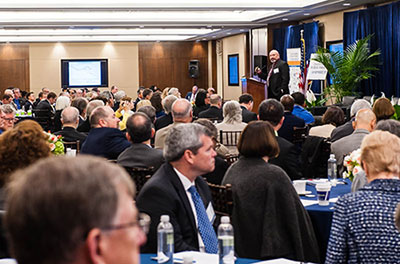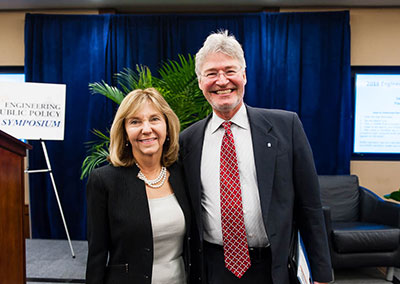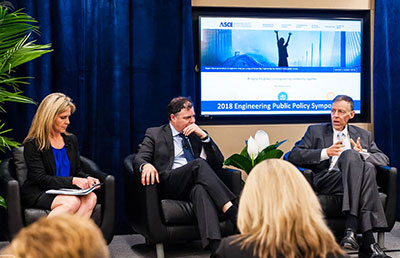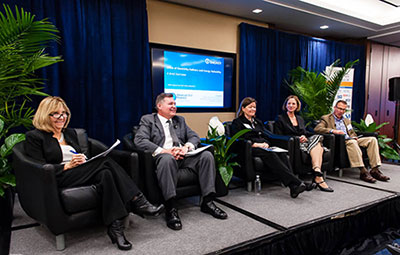Public Policy Symposium Highlights Issues Pertaining to U.S. Innovation and Competitiveness
Public Policy Symposium Highlights Issues Pertaining to U.S. Innovation and Competitiveness
May 11, 2018

More than 150 leaders — the presidents, presidents-elect and executive directors — from 45 professional engineering societies, representing more than two million engineers, recently attended the annual Engineering Public Policy Symposium, which was convened on April 24 on Capitol Hill in Washington, D.C.
This was the 15th year that ASME served as the lead organizer of the event. The symposium is designed to inform and engage leaders of the engineering community on public policy issues that are important to advancing research and technology. The event was held in conjunction with the National Academy of Engineering (NAE) Convocation and American Association of Engineering Societies, and was made possible by a grant from the United Engineering Foundation and its Founder Societies: ASME, AIChE, AIME, ASCE and IEEE-USA.
ASME President Charla Wise welcomed the leaders of the engineering community and thanked them for their continued participation. Wise informed attendees that the focus of the meeting was on policy priorities pertaining to “Federal Investments in Engineering and Science to Spur Innovation and Competitiveness.” She briefly discussed some of the findings of the National Science Board report titled “Science and Engineering Indicators 2018,” released earlier this year, which emphasizes that although the United States continues to be the global leader in science and technology (S&T), the U.S. global share of S&T activities continues to decline as other nations — especially China — continue to rise.

Patrick J. Natale, executive director of the United Engineering Foundation, then introduced the Keynote Speaker, Walter G. Copan, Ph.D., Under Secretary of Commerce for Standards and Technology and Director of the National Institute of Standards and Technology (NIST). Dr. Copan discussed a new initiative titled “Unleashing American Innovation” and the interactions NIST has been having with the Office of Science and Technology Policy and the interagency National Science and Technology Council, as well as stakeholders in the public and private sectors across the nation to assess and improve the transfer of technology from federally funded R&D.
Next, IEEE-USA President Sandra “Candy” Robinson introduced Matt Hourihan, director of the R&D Budget and Policy Program at AAAS, who provided an in-depth review of the status of federal funding for science and engineering research, as well as an overview of the president’s proposed budget request for Fiscal Year 2019 (FY19) that was released in February. Hourihan noted that President Trump signed into law a $1.3 trillion spending package in March that included significant increases by Congress for federally sponsored scientific research, infrastructure and science, technology, engineering and mathematics (STEM) education.

The past president of AIChE, Maria Burka, then introduced the next panel session, which included ASCE President Kristina Swallow, who moderated a discussion between Stephen Bayless, vice president of Public Policy and Regulatory Affairs with the Intelligent Transportation Society of America, and Robert Atkinson, president of the Information Technology and Innovation Foundation (ITIF), on “Investing in Traditional and Innovation Infrastructure.” Bayless discussed smart transportation and autonomous vehicles, as well as other emerging technologies that are changing transportation. Atkinson briefly discussed an ITIF report entitled “Investing in Innovation Infrastructure to Restore U.S. Growth.” In the report, ITIF makes the case that the U.S. should consider investments in “innovation infrastructure,” such as scientific and engineering research, which would enable technological advancements and therefore higher productivity and growth levels.
Later in the morning, ASME President Charla Wise moderated a panel discussion with officials from key federal research agencies on the topic of “Investing in Transformative Technologies.” The panel was comprised of Michael F. Molnar, director of the Advanced Manufacturing National Program Office with the National Institute of Standards and Technology (NIST); Dr. Dawn Tilbury, assistant director of the Engineering Directorate with the National Science Foundation; Valri Lightner, deputy director (acting) of the Advanced Manufacturing Office with the Department of Energy’s Office of Energy Efficiency and Renewable Energy; and Eric Lightner, director of the Federal Smart Grid Task Force with the Department of Energy’s Office of Electricity Delivery and Energy Reliability. Michael Molnar and Valri Lightner discussed how advanced manufacturing technologies and the work of the Manufacturing USA Institutes enable crosscutting innovation in a variety of engineering disciplines. Dr. Tilbury discussed NSF’s 10 “Big Ideas,” which are meant to catalyze interest and investment in fundamental research, which is the basis for discovery, invention and innovation. Finally, Eric Lightner discussed enabling a more secure and reliable electric grid, including resilience against cybersecurity threats and extreme weather events.

To conclude the event, John Speer, Ph.D., AIME president, introduced two ASME Congressional Fellows: Andrew Bicos, Ph.D. serving in Congressman Tom Reed’s (R-NY) office, and Shawn Moylan, Ph.D., serving in the office of Senator Gary Peters (D-MI). Tanya Das, an Optical Society of America-International Society for Optical Engineering/AAAS Fellow serving in Sen. Chris Coons’ (D-DE) office, joined Dr. Bicos and Dr. Moylan to discuss the opportunities and challenges the Fellowships provided, as well as the broad issues portfolios they addressed. In particular, they emphasized the bipartisanship they encountered in moving legislation forward.
At the end of the symposium, several attendees took the opportunity to meet with their members of Congress in the U.S. House of Representatives and U.S. Senate to strengthen their relationships with policymakers, inform them of the importance of investments in federally funded research and development, as well as to offer their services as a technical resource to policymakers.
Anne Nadler, ASME Government Relations Representative




